#spatial analysis
Explore tagged Tumblr posts
Text
youtube
TOMORROW. (i'll be there to chat and answer questions, etc. hope to see you there!)
#silent hill#silent hill 4#video essay#spatial analysis#analysis#horror#survival horror#horror game analysis#horrorgameanalysis#horror game#silent hill 4: the room#henry townshend needs to get a personality#Youtube
4 notes
·
View notes
Text
How to use GIS for Soil Mapping and Crop Monitoring
Soil health and crop productivity are directly tied to how well we understand the land beneath our feet. Yet, one of the biggest challenges farmers, agricultural scientists, and policymakers face is making sense of diverse, scattered data about soil types, nutrient availability, and crop coverage. That’s where GIS come in. GIS allows us to consolidate, visualize, and analyze this data spatially—helping turn raw numbers into decisions that improve yields and sustainability.
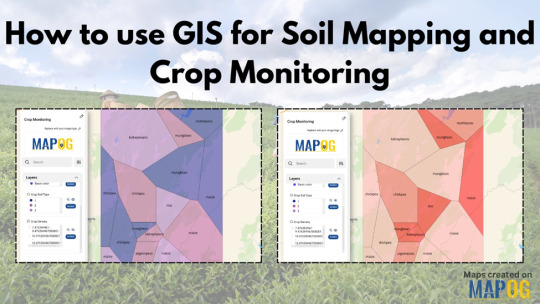
GIS: Bridging Soil Science and Smart Agriculture
GIS isn’t just about maps—it’s a full-blown analytical system that lets you layer, compare, and interpret complex datasets. When applied to soil and crop monitoring, GIS becomes a powerful tool to visualize patterns across large areas: where soil is fertile, where it's degrading, or where certain crops are thriving or failing. Instead of working with spreadsheets or text reports, you can literally see what's happening in the field.
For example, by collecting point-based data on soil moisture, pH, or nutrient density, and then converting it into polygon layers, one can observe how these attributes vary across a landscape. You can even overlay crop yield data to detect trends, inefficiencies, or threats like erosion or over-farming. Visualization modes like “by category” or “by quantity” help highlight differences in soil types or crop densities across regions, letting you respond with targeted action.
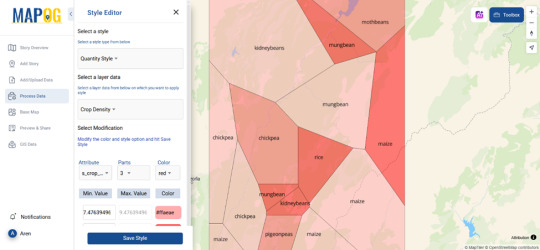
Industries Benefiting from GIS in Agriculture
Modern agriculture is already shifting from intuition-based to data-driven decision making, and GIS is central to that transition. Large-scale farms use it for precision farming—deciding which parts of a field need more or less irrigation or fertilization. Government agencies use GIS-based maps to monitor food security, plan subsidies, or enforce land-use policies. Agri-tech startups, environmental consultancies, and even NGOs are leveraging it to create sustainable farming models that can be scaled across regions.
A Practical Way to Begin
If you're curious about applying GIS without diving into complex software, One such example is MAPOG, where you can upload your geospatial data and transform it into interactive stories or analysis-ready visualizations. It’s especially helpful for users looking to combine GIS with storytelling—ideal for reports, presentations, or even education.
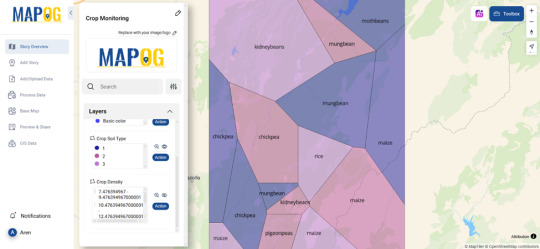
Conclusion:
Whether you're managing a farm, analyzing policy impact, or running sustainability programs, GIS offers a way to make soil and crop monitoring clearer, faster, and more effective. When data meets maps, decision-making becomes smarter. If you’re dealing with agricultural data and looking for a tool to visualize and understand it better, it’s worth trying platforms like MAPOG to see how it can elevate your analysis.
#mapog#gis#spatial analysis#mapping#SoilMapping#CropMonitoring#GISinAgriculture#sustainablefarming#agritech#agriculture
0 notes
Text
Mastering QGIS Desktop 3.34 LTR: From Beginner to Pro.
English Video tutorial, just for $9.99 (NORMAL price $19.9). Get it once and you will get endless access right.
Unlock the full potential of QGIS Desktop 3.34 LTR! This comprehensive guide takes you from the basics to advanced spatial analysis, helping you master GIS techniques, data visualization, and automation with Python. Whether you're a beginner or an experienced user, this book will elevate your GIS skills.
#QGIS 3.34#QGIS tutorial#GIS software#spatial analysis#QGIS Python#mapping software#open-source GIS#QGIS for beginners
0 notes
Link
#Population dynamics#Spatial analysis#Geographic information system#Zamboanga Sibugay province#Urbanization trends
1 note
·
View note
Text
Exploring Local Communities Through Carmel Zip Codes

Credit: Image by Republica | Pixabay
An Overview of Carmel Zip Codes and What They Offer
Imagine moving to a new city or planning a trip to an unfamiliar territory; without clear guidance, you may waste time searching for activities that match your interests. Well, the unsung heroes of geographical organization are zip codes! If you wish to explore the coastal area of the Monterey Peninsula and the beautiful Carmel-by-the-Sea, break it down into manageable parts to find what you're looking for with ease and precision. Here's an in-depth look at notable Carmel zip codes and what they offer.
What Are The Carmel Zip Codes?
Carmel Village itself and its surrounding areas are predominantly within the 93921 zip code. The more remote parts, such as Carmel Highlands and Carmel Valley, are zoned under 93923 and 93924 zip codes, depending on the specific area. These Carmel zip codes mark neighborhoods and districts and showcase unique lifestyles and attractions.
Why Use Carmel Zip Codes When Exploring?
Carmel’s zip codes help visitors and residents explore the area, understand its geography, and discover what each part offers.
Pinpoint Diverse Neighborhoods Carmel zip codes represent a unique aspect of living, from the bustling charm of downtown to the quiet luxury of cliffside communities or the sun-drenched appeal of inland areas.
Tailor Experiences to Preferences Carmel zip codes can guide you to areas with attractions that match your interests. Love the beach? Focus on 93921. Prefer vineyards and open spaces? Head to 93924.
Ease Real Estate Searches Homebuyers can use Carmel zip codes to target specific lifestyles, property types, and price ranges. These codes help streamline the search for their dream home, whether they seek a coastal cottage or a sprawling valley estate.
Discover Hidden Gems Carmel zip codes often include lesser-known spots that might not appear in general guides. For instance, 93922 offers serene hiking trails and stunning ocean views less heavily marketed than downtown Carmel's attractions.
Simplify Navigation Exploring the Carmel region using zip codes makes it easier to navigate, whether you're planning a trip or relocating.
Get To Know Carmel Zip Codes
93921: Carmel-by-the-Sea’s Storybook Charm
The 93921 Carmel zip code is inseparable from charming downtown and the surrounding neighborhoods. This area offers charming scenery of fairy-tale cottages, small-styled shops, and beautiful artistic galleries. Roads are easy to walk, and the neighborhood environment creates a village vibe, making it suitable for people who have retired, families, and working people.
Homes in this area range from small bungalows to multimillion-dollar estates. Dining options are abundant. Parking and home prices can be challenging, but the unique charm outweighs the drawbacks for many.
93923: Coastal Elegance of Carmel Highlands
93923 zip code covers Carmel Highlands, which is located to the south of Carmel-by-the-Sea. This area is affluent, with cliff homes and villas with breathtaking vistas of the Pacific Ocean from their balconies. Some rank among the most costly in the region and cater to luxury buyers.
Carmel Highlands appeals to those seeking tranquility and high-end living. The atmosphere is rural, the location is relatively secluded but it is only a few minutes’ drive from Carmel town proper. Places of interest include Point Lobos State Natural Reserve which offers trails as well as wildlife viewing opportunities.
93924: Carmel Valley’s Vineyards
Carmel Valley is famous for its sunny weather and wine-country vibes. Bernardus and Holman Ranch wineries are among the many that make this area a wine-lover destination. In addition to vineyards, golf courses, and equestrian properties define the area.
Homes in 93924 often have large lots, perfect for anyone seeking a quiet retreat. They are less expensive than coastal Carmel but require a longer commute to the beach and shopping centers.
93920: Big Sur’s Rugged Beauty
The 93920 zip code includes Big Sur, which is famed for its stunning topography along the edges of the ocean. Due to its aforesaid features, this region is perfect for those who are in search of solitude and stunning landscapes. Many houses rest at the cliff edges affording extraordinary views of the sea.
Big Sur is a haven for artists, nature enthusiasts, and those who crave privacy. However, living here means limited access to amenities. Residents often travel to Carmel or Monterey to shop and dine.
93940: Monterey’s Urban Convenience
93940 includes Monterey. Though not part of defined Carmel zip codes, it is definitely close. This area is ideal for those who want proximity to downtown Monterey, Cannery Row, and the Monterey Bay Aquarium.
Homes here range from historic Victorians to modern condos, catering to various budgets. The area boasts excellent schools, parks, and family-friendly activities. Monterey’s vibrant cultural scene and stunning bay views make it a desirable destination.
93950: Pacific Grove’s Coastal Retreat
The 93950 zip code covers Pacific Grove, located just north of Carmel. This charming seaside community features historic homes, coastal trails, and a laid-back lifestyle.
The Lovers Point Park and Asilomar State Beach are favorite spots for outdoor activities. Homes here are more affordable than those with Carmel zip codes, attracting families, retirees, and first-time buyers.
93953: Exclusive Pebble Beach Living
Pebble Beach is an internationally renowned community. This area is synonymous with prestige and is known for its luxury estates and world-class golf courses. Residents enjoy gated privacy, stunning ocean views, and access to the famous 17-mile Drive.
Pebble Beach is perfect for golf enthusiasts and affluent buyers looking for exclusivity. The area’s top-tier schools and peaceful surroundings also attract families. With high property values and HOA fees, living here requires a significant financial commitment. However, for those who can afford it, Pebble Beach offers unparalleled luxury.
93955: Affordable and Accessible Seaside
Seaside is just north of Monterey. This area is one of the more affordable options near Carmel zip code addresses. It is a practical and budget-friendly option for coastal living.
It has a mix of older homes, newer developments, and some apartments. It is close to California State University Monterey Bay and Fort Ord National Monument.
Wrap Up
Carmel’s zip codes offer distinct lifestyles, from rugged beauty to unparalleled luxury. Whether you prioritize affordability, exclusivity, or proximity to nature, the Monterey Peninsula has something for everyone. Understanding what each zip code offers can help you find the perfect fit for your needs.
Visit https://heinrichbrooksher.com/zip-code-map/ to explore the unique neighborhoods defined by Carmel zip codes and find your perfect coastal home today.
Explore the stunning coastal neighborhoods, lifestyles, and attractions with our complete Carmel zip code guide!
#Community Information#Real Estate Blogs#Real Estate#Carmel CA Real Estate#Carmel CA Realtor#Carmel CA Homes#Carmel CA Neighborhoods#Carmel CA Communities#Carmel-by-the-Sea ZIP Code Map#Carmel CA Postal Codes#Monterey County ZIP Code Map#Carmel 93923 Boundary Map#93921 Carmel Downtown Map#California ZIP Code Locator#Carmel Neighborhood Maps#Carmel CA Real Estate Map by ZIP Code#Zip Code Boundaries#Mapping Carmel CA#Carmel CA Demographics#Geographic Information System#County Map#Municipalities#Census Data#Urban Planning#Demographics#Cartography#Spatial Analysis#Geographic Data Visualization#Boundary Mapping
0 notes
Text
me fr
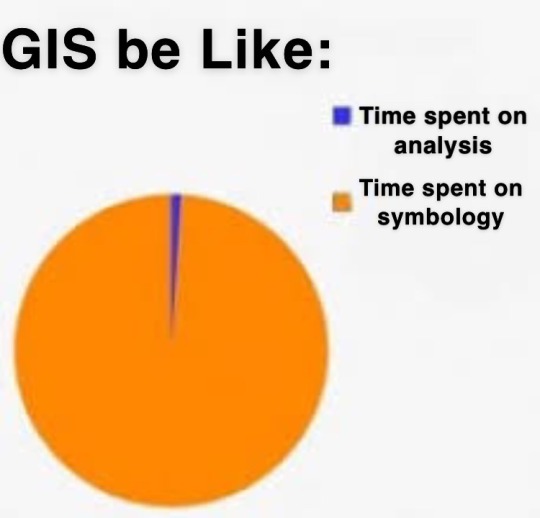
why is the default symbology the ugliest thing ive ever seen like Who want a map that looks like That
54 notes
·
View notes
Text

absolutely fuckin. riveting insight from the GIS textbook. thank you so much. also great job using language like a human person, really nailed it there.
#now it is the migration season for the older criminals#once they develop greater mobility they can travel en masse to the central business district#where they gather for their annual Crime Displays#(I've started writing CRIME MENTION!!! in my lecture notes every time ~crime analysis~ gets brought up as a use for GIS)#(literally at least once almost every. damn. week.)#(part of this class is supposed to be like. developing a critical eye toward irl equity dynamics with spatial analysis)#(Y'ALL. CAN WE START WITH THE FUCKING TEXTBOOK.)#(Official How To ArcGIS Book from Official ArcGIS Developer Organization =/= good critical pedagogy)#(but don't worry; it's also not good at teaching (me) how to use the program too!)#James liveblogs grad school#hi. I'm in. a goddamn mood this week. apparently.#stabbing mood. many stabbings.
9 notes
·
View notes
Text


6th of September 2023
🇩🇰 I love to bike everywhere! My butt hurts tho.
Learning a lot about remote sensing and spatial urban analysis this term 🍀
#studyblr#geography#study#desk#motivation#uni#mine#study setup#studying#study aesthetic#spatial studies#Remote sensing#analysis#studyspo#Copenhagen
54 notes
·
View notes
Text
Elden Ring: a cross between Absurdism and Surrealism
Upon reflection, I'd say the genre of the base game is pretty decently rooted in the theatre of the absurd. One of the main themes of that movement being the failure of language to clearly communicate ideas, leading to confusion and loss of direction.
Skimming over some articles on traditional absurdist literature, the three responses to the absurd are termination of the self (Frenzy Flame), turn to religion or some other higher purpose (any Elden Lord end), or rebel against the absurd. Which is to say embrace and accept the profound meaninglessness and go on anyways (Age of Stars). The Blessing of Despair is perhaps also an acceptance of the absurd, only it's with bitterness from a more narcissistic nihilism viewpoint when contrasted again Ranni's path. Space is cool, stars are cool. Even worms and dirt are cool, but not with the attitude the Dungeater has.
The DLC is something else entirely, and in fact I'd speculate that it's a genre shift from absurdism to surrealism. The aesthetic framing of the cocoon entry point itself was a play on Salvador Dali's “Geopoliticus Child Watching the Birth of the New Man” so the inspiration is right there in the open. There is indeed a difference between those two movements, as described by someone who has read the relevant literature more thoroughly and recently than I have:
"Absurdist writing focuses on the inherent purpose of life being elusive or questioned, can use dark humor to comment on the human condition, and explores themes of existentialism and purposelessness. Surrealism is marked by disjointed and occasionally fantastic imagery, irrational juxtaposition, and can be dreamlike"
Notably, the Shadowlands is another contrast against the Age of Stars in that it's a dead end that reflects upon the motifs if the past but offers no path forwards. It examines the ascent to "God and Lord" at a high point of the map and the Frenzy at the lowest depth and all of the other bits sandwiched between those two extremes.
Basically, the Lands Between is absurdism with the aesthetics of surrealism and the Shadowlands seem to show what it means to dive into surrealism while maintaining the theme of breakdown of communication that is characteristic of absurdism. Surrealist writing would be vague and cryptic and evocative of imagery. Absurdist writing is about people saying perfectly coherent words, but still talking past each other because they are asking the wrong questions and can't establish a common ground. In this sense "clarity" is a trap - the truth that you think you understand is not always what was said.
Similar to Demon's Souls, Dark Souls, and Bloodborne, the gothic medieval fantasy is a thin veneer for whatever philosophical or artistic movement FromSoft feels like exploring at the moment.
#Elden ring#shadow of the erdtree#analysis of art design#media analysis#I'm personally fond of 'Rosencrantz and Guildenstern are Dead' although I read 'Zoo Story' for a class#There are just so many layers of communication in visual and spatial and auditory and real world context in Elden Ring#Much more going on than dialogue and item descriptions
14 notes
·
View notes
Video
DSC_0333 Architectural Space (Collage) by Russell Moreton Via Flickr: russellmoreton.blogspot.com russellmoreton.tumblr.com
#collage#architectural#interior#photography#fragments#layers#ruins#material#place#site#reading#spatiality#working process#design#architecture#visual art#speculative#subjective#analysis#construction#making#Russell Moreton#visual fine art#spatial practice#research creation#ecology of experience#useless flickr uploader#flickr
2 notes
·
View notes
Text
ok im back to hating everything. My prof really did NOT do a good job this semester I feel completely unprepared and… I’m aware that what I’m trying to do is so much more complex than what we covered in class but normally I don’t have problems to scale things up like this but I think I severely underestimated the complexity of what I’m trying to model. Lol. god I’m so scared bc a huge part of my research hinges on me figuring this out and I have NO ONE I can ask bc no one works with QGIS on this scale so help me fucking g-d lmaoooo 😭
#I’ll be alright I’ll be ok#I’m just venting#I do know people who work with it but they’re acquaintances and it’ll be weird if I ask for help out of the blue#I WILL ask them but not for this assignment cos it’s due on Wednesday 😂#it’s just a little trial run so I’m ok bc I think I have enough data for that#I’m just gonna do some raster analysis tmrrw bc I’m good at that#and then hopefully he won’t notice that I have no fucking clue how to interpret the spatial lag model lololol#I just don’t fucking understand what my output is tbh#like. 😭 too many variables and they’re so weirdly spatially distributed but I don’t understand where that comes from bc#they should be clustered bc I RECORDED them as clusters myself#is it bc the stupid model doesn’t understand that there’s 5 clusters? and it treats it like they are one giant cluster?#I don’t know! and neither does the fucking internet apparently! 😂#UAGGHHHH ok time to go to bed#shut up Sam
2 notes
·
View notes
Text
actually it is, its called an equal-area projection:
there are 3 core properties (there are more but we're not going there) that a map can represent about a physical space: shape, area, and distance. these 3 properties can be picked and chosen while deciding how to project your map but its impossible to have all 3 because, well, like said above, Earth is a spheroid.
a map that preserves shape (mostly at small scales) is called conformal, which is what the Mercator projection is, and they are mutually exclusive with equal area maps. there's also equidistant maps which preserve distance, but they typically only function at a small scale across one meridian. Mercator is also what you'd call a true direction map, meaning that unlike the equal area example above, the landforms are arranged essentially the way they would be on a globe. in other types of projections, the angles are a bit off
so, Earth being round doesn't mean its not possible to project a map where the sizes are accurate. it just means that maps that have accurate areas sacrifice the accuracy of shape and/or distance
i know this probably wasnt the question asked, they may have been more interested in the impossible map that normalizes all 3 of those constants, but i feel like projections like this that have mathematic or scientific appeal but not practical or aesthetic appeal don't get the appreciation they deserve.
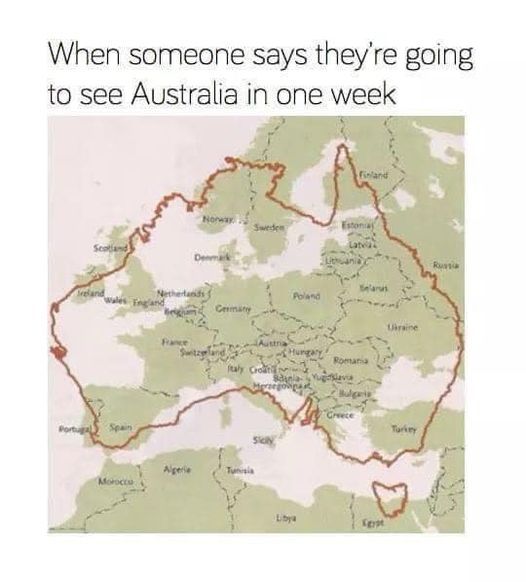
In their defence, a lot of it is sand.
40K notes
·
View notes
Text
How GIS Can Predict and Mitigate the Effects of Rising Sea Levels?
Rising sea levels pose a serious threat to coastal communities, ecosystems, and infrastructure worldwide. Geographic Information Systems (GIS) provide a powerful way to analyze, predict, and mitigate these impacts using real-time spatial data and advanced mapping techniques.
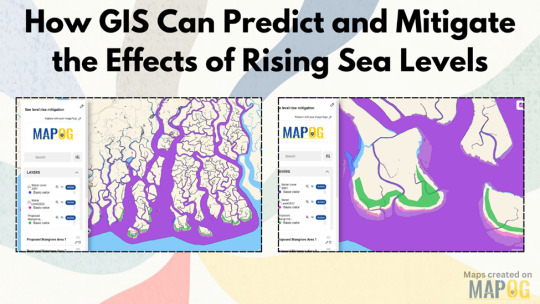
Understanding the Threat: What GIS Reveals About Rising Waters
GIS allows scientists and policymakers to visualize past and present water levels to predict future risks. By analyzing historical water level data—such as from 2001 and 2022—GIS can create accurate models to identify areas at high risk of flooding. This helps in forecasting potential damage and preparing preventive measures.
Using GIS for Risk Assessment and Mitigation
Mapping Vulnerable Zones GIS overlays different datasets, such as elevation models, climate data, and urban development, to pinpoint the most vulnerable regions. This helps authorities focus on high-risk coastal areas that need urgent intervention.
Proposing Natural Solutions One effective mitigation strategy is mangrove restoration. Mangroves act as natural barriers, reducing coastal erosion and absorbing excess water during storms. By using GIS tools to map potential mangrove plantation sites, we can strategically enhance these natural defenses.
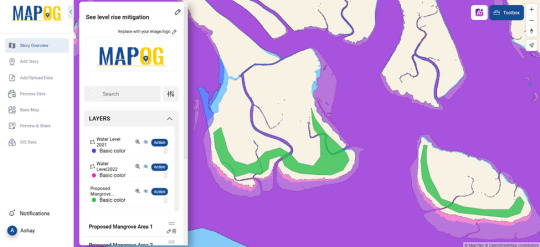
Urban Planning and Infrastructure Resilience City planners can use GIS simulations to design flood-resistant infrastructure, such as elevated roads, drainage systems, and protective sea walls. Identifying evacuation routes and emergency shelters also becomes more efficient through GIS mapping.
How GIS Tools Help in Real-Time Decision Making
Platforms with interactive mapping capabilities enable researchers and policymakers to update their models as new data becomes available. For instance, some GIS platforms allow users to upload historical water level data, create proposed mitigation zones, and analyze changes over time—all within an intuitive mapping interface.
If you're working on coastal resilience planning, exploring GIS-based platforms can help visualize and implement effective mitigation strategies. Platforms like MAPOG allow users to overlay water level data, draw mitigation zones with “Add polygon” tool, and create interactive maps that aid in decision-making and see how mapping can be a game-changer in combating rising sea levels.
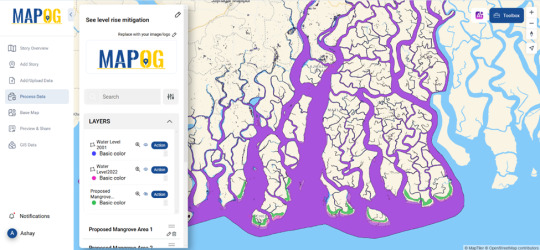
Final Thoughts
Rising sea levels require proactive solutions, and GIS plays a crucial role in understanding and mitigating this challenge. From data-driven predictions to ecosystem-based solutions, GIS empowers decision-makers with the insights they need to protect vulnerable communities.
How do you think GIS can improve coastal resilience in your region? Let us know in the comments!
#mapog#sea level rise#risk mitigation#gis#mapping#spatial analysis#data visualization#water mitigation#climate change mitigation
0 notes
Text

Mastering QGIS Desktop 3.34 LTR: From Beginner to Pro. Unlock the full potential of QGIS Desktop 3.34 LTR! This comprehensive guide takes you from the basics to advanced spatial analysis, helping you master GIS techniques, data visualization, and automation with Python. Whether you're a beginner or an experienced user, this book will elevate your GIS skills.
English Video tutorial, just for $9.99 (NORMAL price $19.9). Get it once and you will get endless access right. Visit:
#QGIS 3.34#QGIS tutorial#GIS software#spatial analysis#QGIS Python#mapping software#open-source GIS#QGIS for beginners
0 notes
Text
#Spatial Omics Market#Spatial Omics Market Size#Spatial Omics Market Share#Spatial Omics Market Trends#Spatial Omics Market Growth#Spatial Omics Market Forecast#Spatial Omics Market Analysis
0 notes
Text
The Zip Codes of Tennessee: Music, History, and Nature

Credit: Image by The Polzel Group | Source
Understanding the System of Zip Codes of Tennessee
Tennessee is one of the many states in the southeast region of the United States of America. It is known for its music, its big and nice cities and of course, stunning landscapes. Like many other states, the zip codes of Tennessee correspond to various areas and districts. Every zip code has a story behind it; it can consist of a downtown area, suburban homes, and vast farmlands.
This guide will describe the various Tennessee zip codes, focusing on their relative locations and distinctive features.
Zip codes are area codes that the United States Postal Service (U.S.P.S.) uses to quickly identify specific areas where mail will be delivered.
Tennessee zip codes start from 37, 38, or 39 and show a position hearing its place in the national zip code system. Such codes have functions in day-to-day practical life and assist in recognizing and differentiating between several areas of the state.
Major Metropolitan Areas
Nashville (37201-37250)
Zip codes of Tennessee range from 37201 to 37250, and Tennessee has many fantastic cities, among which the capital city is Nashville. The home of country music, Nashville also features site attractions that include great eating and drinking points and landmarks. Key neighborhoods include:
Downtown (37201, 37203): The Nashville tour guides encompass the Ryman Auditorium bridge-stone Arena and the Country Music Hall of Fame.
East Nashville (37206): An artsy district focusing on elaborate outlets and appealing to the creative spiritually, with non-routine eating places.
Green Hills (37215): A luxurious district of Nashville with upper-class shopping, such as The Mall at Green Hills, and impressive houses.
Memphis (38101-38197)
Memphis has a musical and numerical history, especially in zip codes 38101 to 38197. This city in the United States of America is situated on the Mississippi River, with significant historical landmarks and traditions.
The city on the Mississippi River has essential cultural and historical landmarks and fantastic sites and attractions.
Midtown (38104): Unanimously considered for its cobblestone streets full of adorable historic houses, flamboyant arts culture, and the famous Memphis Zoo.
Germantown (38138, 38139): A peaceful residential town with good schools, parks, and everything a family may need daily.
Knoxville (37901-37998)
Knoxville is near the Great Smoky Mountains, and the zip codes available in this city range from 37901 to 37998. This city is known for its outdoor activities, cultural festivals, and the University of Tennessee.
Outdoor recreation, annual celebrations, and the University of Tennessee are related to this city.
Downtown (37902): It has the Market Square, Tennessee Theater, and a museum of art in Knoxville.
West Knoxville (37919, 37922): This area boasts well-established shopping malls, such as West Town Mall, and numerous parks and recreational places.
North Knoxville (37917): A color-drenched region with bright streets developed with renovated houses and attractive shops, cafes, and restaurants.
Regional Highlights
Chattanooga (37401-37450)
Chattanooga is a beautiful city with zip codes 37401 and 37450. Key attractions and neighborhoods include. Below are some of the key attractions and catchy neighborhoods to visit:
Downtown (37402, 37403): Tennessee Aquarium, the famous walking bridge, popularly known as the Walnut Street bridge and The Hunter Museum of American Art.
Northshore (37405): A place with numerous shops, restaurants, and cafes with water frontage parks.
East Brainerd (37421): This suburban area houses shopping malls like Hamilton Place Mall and other family-oriented institutions.
Clarksville (37040-37044)
Suited explicitly for bottled gas activity, Clarksville, neighboring the Kentucky border, encompasses zip codes 37040 through 37044. This city is known for its military presence and historical sites.
From what one can see, this city looks entirely military, and there are many attractions of archeological interest here:
Downtown (37040): This section illustrates the Customs House Museum, existing constructions, building arts, and emerging cultural scenes.
Sango (37043): A suburb with a recent formation, beautiful scenery of parklands, and education facilities.
Fort Campbell (37042): Serving a population near the famous Fort Campbell-based military, the company has the chance to access the larger population and social services.
Murfreesboro (37127-37130)
Murfreesboro is a city in Nashville's metropolitan area with zip codes 37127, 37129, and 3713. This rapidly growing city is known for its historic significance and modern amenities.
It attracts people owing to its history and facilities provided for the contemporary population.
Downtown (37130): It boasts Middle Tennessee State University, a well-known university, Cannonsburgh Village, one of the oldest towns in the state, and an active town square.
Blackman (37128): Neighborhood for new residential, child care centers, schools, I.G.A., and new shopping cart.
North Murfreesboro (37129): These neighborhoods are well-endowed with beautiful views of parks, golf courses, and family-based neighborhoods.
Rural and Suburban Areas
Franklin (37064-37069)
Franklin is a beautiful city with a historical background in zip codes 37064-37069. Known for its charming yet lively downtown and historic sites. Famous for lovely downtown and historic points of interest:
Cool Springs (37067): Provides excellent locations for all merchandising and shopping needs. Retail shops, boutiques, specialty shops, and larger, better-quality retail stores can do well here since the area is alive with people.
Johnson City
Johnson City is located in the northeastern part of the state and has zip codes 37601, 37614, and 37615. This city is known for its outdoor activities and vibrant arts scene.
It is generally an excellent place for those who like different types and levels of physical activity and for creative individuals.
Boones Creek (37615): Stretching suburban area with numerous residential buildings, schools, schools, and parks.
South Johnson City (37604): Home of the East Tennessee State University and James H. Quillen VA Medical Centre.
Maryville (37801-37804)
Maryville occupies a central position as a gateway town for the Great Smoky Mountains, and the city corresponds with postal codes 37801, 37802, 37803, and 37804.
The city is known for its outdoor recreation and family-friendly atmosphere. This city is all about the sunshine stretched across the landscapes and the friendly company of families.
Downtown Maryville (37801): Shows the capitol theater, shops in the area, and events in the community.
Alcoa (37804): A competitor city with an operational airport, other industrial-based areas, and residential areas.
Conclusion
Tennessee's codes are another exciting way of understanding counties in various areas of the state. Every city is unique, though they share general features; some are lively cities like Nashville, Memphis, and Knoxville, whereas others are beautiful places such as Chattanooga, Clarksville, and Murfreesboro.
So, no matter what area you wander from the central historic city to your Tennessee suburbs, the Tennessee zip code accurately represents the state's way of life.
Ready to learn more? Visit our website at https://livingthenashvillelife.com/zip-code-map/ for comprehensive information.
#Community Information#Real Estate Blogs#Homes for Sale#Nashville TN Real Estate#Nashville TN Homes#Nashville TN Zip Code#Davidson County#Navigation#Regional#Boundaries#Postal codes#Cartography#Zip codes#Geography#Location#Geographic Information System#County Map#Census Data#Demographics#Spatial Analysis#Geographic Data Visualization#Boundary Mapping
1 note
·
View note
